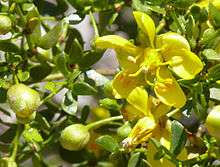Senna wislizeni
| Wislizenus' Senna | |
|---|---|
 | |
| Flowering branch | |
| Scientific classification | |
| Kingdom: | Plantae |
| (unranked): | Angiosperms |
| (unranked): | Eudicots |
| (unranked): | Rosids |
| Order: | Fabales |
| Family: | Fabaceae |
| Subfamily: | Caesalpinioideae |
| Tribe: | Cassieae |
| Subtribe: | Cassiinae |
| Genus: | Senna |
| Species: | S. wislizeni |
| Binomial name | |
| Senna wislizeni (A.Gray) Irwin & Barneby | |
| Synonyms | |
|
Cassia wislizenii A.Gray | |
Senna wislizeni is commonly called Wislizenus' senna[1] or shrubby senna (formerly "cassia", but this generally refers to larger Cassiinae). Formerly in the "wastebin taxon" Cassia sensu lato, it is now placed in the genus Senna or sometimes separated in Palmerocassia together with Senna unijuga.[2]
This is a perennial, deciduous shrub native to Chihuahua and Hidalgo in Mexico; and Texas, New Mexico, and Arizona in the U.S. It is a desert plant with good heat and drought tolerance.
Senna wislizeni can reach ten feet (3 meters) tall with a ten-foot spread. It has compound foliage. In summer, especially late summer, it bears yellow flowers developing into long, flat, dark brown pods. Flowers are visited by carpenter bees, and bumblebees. Sulphur butterflies use the plant as a larval food source.[3]
The species is named after Dr. F. A. Wislizenus, a botanist who studied Mexican flora in the mid-19th century. Some sources mistakenly spell the epithet "wislizenii." Correct spelling is with one "i," per ICN article 60C.2.[4]
There are several named varieties:[2]
- var. painteri (Britton & Rose) H.S.Irwin & Barneby (= Cassia wislizenii A. Gray var. painteri (Britton & Rose) H.S.Irwin & Barneby, Palmerocassia painteri Britton & Rose)
- var. pringlei (Rose) H.S.Irwin & Barneby (= Cassia morelensis Greenm., Cassia pringlei Rose, Palmerocassia pringlei (Rose) Britton & Rose)
- var. villosa (Britton & Rose) H.S.Irwin & Barneby (= Cassia wislizenii A. Gray var. villosa (Britton & Rose) H.S.Irwin & Barneby, Palmerocassia villosa Britton & Rose)[5]
Footnotes
- ↑ "Senna wislizeni". Natural Resources Conservation Service PLANTS Database. USDA. Retrieved 10 November 2015.
- 1 2 ILDIS (2005)
- ↑ Soule, J.A. 2012. Butterfly Gardening in Southern Arizona. Tierra del Soule Press, Tucson, AZ
- ↑ J. McMeill et al. (eds). 2012. International Code of Nomenclature for algae, fungi, and plants. Regnum Vegetabile 154. Koeltz Scientific Books. ISBN 978-3-87429-425-6
- ↑ Note that there also exists a Senna villosa (Mill.) H.S. Irwin & Barneby (formerly Cassia villosa Mill.) which is a different species altogether.
References
- International Legume Database & Information Service (ILDIS) (2005): Genera Cassia, Palmerocassia, Senna. Version 10.01, November 2005. Retrieved 2007-DEC-20.
External links
- Desert Tropicals.
- Lady Bird Johnson Wildflower Center.
- GRIN Taxonomy for Plants
- USDA PLANTs Profile
- ITIS Report
